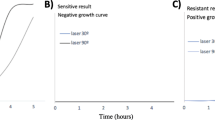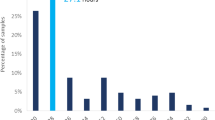Abstract
Inadequate therapy in bloodstream infections is suggested to be associated with higher mortality. We evaluated the reduction in inappropriate antibiotic therapy using rapid identification and antibiotic susceptibility testing (FAST) compared to standard of care (SOC) testing in patients with bloodstream infections. The FAST method used polymerase chain reaction (PCR) for identification and to detect growth in the presence or absence of antibiotics after only 6 h. For SOC testing, the BD Phoenix system was used. Patients with blood cultures growing Staphylococcus, Streptococcus or Enterococcus species or Gram-negative rods were randomised for FAST or SOC tests. A total of 129 patients were randomised for FAST and 121 patients for the SOC group. At the time SOC results became available, 78 patients in the FAST group could have been switched to more appropriate therapy. Although FAST results were highly accurate (agreement with SOC was 94 %), they were only implemented in a minority (16) of patients. However, significantly fewer patients in the FAST group used inappropriate therapy at the time of SOC results (p = 0.025). The time to results in the FAST group was reduced by 15.6 h (p < 0.001). In the patients switched after FAST, this was done after a mean of 42.3 h compared to 61.4 h in those switched after SOC tests (p < 0.001). In bacteraemic patients, FAST resulted in significantly more patients using appropriate antibiotic therapy at the time SOC results were available and 15.6 h earlier than SOC tests. However, the implementation of FAST results was not optimal and no benefit on clinical outcome was shown.

Similar content being viewed by others
References
Fraser A, Paul M, Almanasreh N et al (2006) Benefit of appropriate empirical antibiotic treatment: thirty-day mortality and duration of hospital stay. Am J Med 119:970–976
Ibrahim EH, Sherman G, Ward S et al (2000) The influence of inadequate antimicrobial treatment of bloodstream infections on patient outcomes in the ICU setting. Chest 118:146–155
Kumar A, Roberts D, Wood KE et al (2006) Duration of hypotension before initiation of effective antimicrobial therapy is the critical determinant of survival in human septic shock. Crit Care Med 34:1589–1596
McGregor JC, Rich SE, Harris AD et al (2007) A systematic review of the methods used to assess the association between appropriate antibiotic therapy and mortality in bacteremic patients. Clin Infect Dis 45:329–337
Bouza E, Sousa D, Muñoz P et al (2004) Bloodstream infections: a trial of the impact of different methods of reporting positive blood culture results. Clin Infect Dis 39:1161–1169
Byl B, Clevenbergh P, Jacobs F et al (1999) Impact of infectious diseases specialists and microbiological data on the appropriateness of antimicrobial therapy for bacteremia. Clin Infect Dis 29:60–66
Garnacho-Montero J, Garcia-Garmendia JL, Barrero-Almodovar A et al (2003) Impact of adequate empirical antibiotic therapy on the outcome of patients admitted to the intensive care unit with sepsis. Crit Care Med 31:2742–2751
Kerremans JJ, Verboom P, Stijnen T et al (2008) Rapid identification and antimicrobial susceptibility testing reduce antibiotic use and accelerate pathogen-directed antibiotic use. J Antimicrob Chemother 61:428–435
Livermore DM (2005) Minimising antibiotic resistance. Lancet Infect Dis 5:450–459
Bruins M, Oord H, Bloembergen P et al (2005) Lack of effect of shorter turnaround time of microbiological procedures on clinical outcomes: a randomised controlled trial among hospitalised patients in the Netherlands. Eur J Clin Microbiol Infect Dis 24:305–313
Trenholme GM, Kaplan RL, Karakusis PH et al (1989) Clinical impact of rapid identification and susceptibility testing of bacterial blood culture isolates. J Clin Microbiol 27:1342–1345
Doern GV, Vautour R, Gaudet M et al (1994) Clinical impact of rapid in vitro susceptibility testing and bacterial identification. J Clin Microbiol 32:1757–1762
Barenfanger J, Drake C, Kacich G (1999) Clinical and financial benefits of rapid bacterial identification and antimicrobial susceptibility testing. J Clin Microbiol 37:1415–1418
Beuving J, Verbon A, Gronthoud FA et al (2011) Antibiotic susceptibility testing of grown blood cultures by combining culture and real-time polymerase chain reaction is rapid and effective. PLoS One 6:e27689
Centers for Disease Control and Prevention (CDC) (2014) CDC/NHSN surveillance definitions for specific types of infections. Available online at: http://www.cdc.gov/nhsn/pdfs/pscmanual/17pscnosinfdef_current.pdf. Accessed 21 July 2014
Hansen WL, Beuving J, Bruggeman CA et al (2010) Molecular probes for diagnosis of clinically relevant bacterial infections in blood cultures. J Clin Microbiol 48:4432–4438
Donker GA, Deurenberg RH, Driessen C et al (2009) The population structure of Staphylococcus aureus among general practice patients from The Netherlands. Clin Microbiol Infect 15:137–143
Paterson DL, Ko WC, Von Gottberg A et al (2004) Antibiotic therapy for Klebsiella pneumoniae bacteremia: implications of production of extended-spectrum beta-lactamases. Clin Infect Dis 39:31–37
de Kraker ME, Davey PG, Grundmann H (2011) Mortality and hospital stay associated with resistant Staphylococcus aureus and Escherichia coli bacteremia: estimating the burden of antibiotic resistance in Europe. PLoS Med 8:e1001104
Munson EL, Diekema DJ, Beekmann SE et al (2003) Detection and treatment of bloodstream infection: laboratory reporting and antimicrobial management. J Clin Microbiol 41:495–497
Oosterheert JJ, van Loon AM, Schuurman R et al (2005) Impact of rapid detection of viral and atypical bacterial pathogens by real-time polymerase chain reaction for patients with lower respiratory tract infection. Clin Infect Dis 41:1438–1444
Acknowledgements
The authors would like to thank Su Yan Yue, Rick Thissen, Gertjan Wagenvoort and Charlotte Hakkers for their assistance in the patient inclusion, data collection and laboratory work. This work was supported by the Profileringsfonds azM (grant number PF245). Parts of these results were presented at IDWeek 2012 in San Diego, CA, USA, October 2012.
Ethical standards
The study was approved by the MUMC Medical Ethics Committee. Patients were included after written informed consent was obtained.
Conflict of interest
All authors have contributed significantly to the study. No conflicts of interest were reported by any of the authors. The Profileringsfonds azM had no role in the study design, in the collection or analysis of data, or in the writing or submission of the manuscript.
Author information
Authors and Affiliations
Corresponding author
Rights and permissions
About this article
Cite this article
Beuving, J., Wolffs, P.F.G., Hansen, W.L.J. et al. Impact of same-day antibiotic susceptibility testing on time to appropriate antibiotic treatment of patients with bacteraemia: a randomised controlled trial. Eur J Clin Microbiol Infect Dis 34, 831–838 (2015). https://doi.org/10.1007/s10096-014-2299-0
Received:
Accepted:
Published:
Issue Date:
DOI: https://doi.org/10.1007/s10096-014-2299-0




